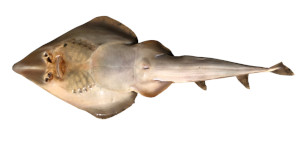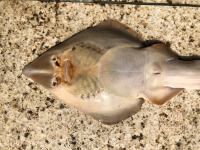Rhinobatos lionotus
Norman, 1926
Smoothback guitarfish
Classification: Elasmobranchii Rhinopristiformes Rhinobatidae
Reference of the original description
A synopsis of the rays of the family Rhinobatidae, with a revision of the genus Rhinobatus. Proceedings of the Zoological Society of London, 96(4), 941–982
A synopsis of the rays of the family Rhinobatidae, with a revision of the genus Rhinobatus. Proceedings of the Zoological Society of London, 96(4), 941–982
Image of the original description
Image in copyright.
Image in copyright.
Synonyms / new combinations and misspellings
Rhinobatus lionotus
Rhinobatus lionotus
Description :
Citation: Rhinobatos lionotus Norman, 1926: In: Database of modern sharks, rays and chimaeras, www.shark-references.com, World Wide Web electronic publication, Version 12/2025
Please send your images of "Rhinobatos lionotus" to info@shark-references.com

Rhinobatos lionotus Norman, 1926, female, TL: 54.8 cm, DW: 21.2 cm, Weight: 558g, 05th January 2020, Cox's Bazar BFDC, Bangladesh © G. M. MASUM BILLAH, Program Coordinator- Marine Mega-Fauna & Fisheries, Wildlife Conservation Society- Bangladesh Program (masumwcsbd@gmail.com)

Rhinobatos lionotus Norman, 1926, female, TL: 54.8 cm, DW: 21.2 cm, Weight: 558g, 05th January 2020, Cox's Bazar BFDC, Bangladesh © G. M. MASUM BILLAH, Program Coordinator- Marine Mega-Fauna & Fisheries, Wildlife Conservation Society- Bangladesh Program (masumwcsbd@gmail.com)
Common names
 Norman"s shovelnose ray,
Norman"s shovelnose ray,  Smoothback guitarfish
Smoothback guitarfish
 Norman"s shovelnose ray,
Norman"s shovelnose ray,  Smoothback guitarfish
Smoothback guitarfish
Short Description
Diagnosis after Last et al. 2019 [27190]: A medium-sized species of the genus Rhinobatos (attaining at least 760 mm TL) distinguished by the following combination of characters: disc wedge-shaped, rather large, width 35–37% TL, length 1.2–1.3 times width; snout relatively short, length 2.5–2.7 times interspiracular distance, ~3.4 times interorbital width; orbit diameter 1.2–1.4 times spiracle length; nostrils moderately oblique, their length 1.3–1.5 times internarial distance; mouth width 6.3–6.9% TL; preoral length 5.5–5.9 times internarial distance; posterior nasal flaps broad; two spiracular folds, outermost fold subequal to marginally taller than inner fold; ridges of rostral cartilage almost parallel, widely separated, converging slightly anteriorly but not constricted medially; anterior cartilage weakly sickle shaped, almost truncate posteriorly; distance between fifth gill slits 2.5–2.7 times in ventral head length; prebranchial sensory pore system obvious, extending posteriorly to margin of first gill slit; postscapular sensory canal notched, with exposed lateral pores; weak thorn patches on supraorbit and scapular region, and row of rudimentary thorns (not conspicuous) along dorsal midline; denticles on dorsal fins densest anteriorly, more sparse posteriorly; dorsal fins small, height of first 7.7–8.1% TL; pelvic-fin inner margin subequal to or shorter than its base length; interdorsal distance 2.3–2.9 times first dorsal-fin base; dorsal caudal margin 1.9–2.0 times preventral margin; upper jaw with ~118 tooth rows; snout angle ~61°; 68–72 pectoral radials; ~164 post-synarcual centra; ~49 nasal lamellae; dorsal fins brownish anteriorly, dusky posteriorly and apically; dorsal disc of adults uniformly brown to greenish, with or without large, regularly spaced cloudy blotches (faint orange to dusky, more or less symmetrically arranged and of irregular sizes); ventral disc and tail pale; no large, black, teardrop marking on undersurface of snout.
Diagnosis after Last et al. 2019 [27190]: A medium-sized species of the genus Rhinobatos (attaining at least 760 mm TL) distinguished by the following combination of characters: disc wedge-shaped, rather large, width 35–37% TL, length 1.2–1.3 times width; snout relatively short, length 2.5–2.7 times interspiracular distance, ~3.4 times interorbital width; orbit diameter 1.2–1.4 times spiracle length; nostrils moderately oblique, their length 1.3–1.5 times internarial distance; mouth width 6.3–6.9% TL; preoral length 5.5–5.9 times internarial distance; posterior nasal flaps broad; two spiracular folds, outermost fold subequal to marginally taller than inner fold; ridges of rostral cartilage almost parallel, widely separated, converging slightly anteriorly but not constricted medially; anterior cartilage weakly sickle shaped, almost truncate posteriorly; distance between fifth gill slits 2.5–2.7 times in ventral head length; prebranchial sensory pore system obvious, extending posteriorly to margin of first gill slit; postscapular sensory canal notched, with exposed lateral pores; weak thorn patches on supraorbit and scapular region, and row of rudimentary thorns (not conspicuous) along dorsal midline; denticles on dorsal fins densest anteriorly, more sparse posteriorly; dorsal fins small, height of first 7.7–8.1% TL; pelvic-fin inner margin subequal to or shorter than its base length; interdorsal distance 2.3–2.9 times first dorsal-fin base; dorsal caudal margin 1.9–2.0 times preventral margin; upper jaw with ~118 tooth rows; snout angle ~61°; 68–72 pectoral radials; ~164 post-synarcual centra; ~49 nasal lamellae; dorsal fins brownish anteriorly, dusky posteriorly and apically; dorsal disc of adults uniformly brown to greenish, with or without large, regularly spaced cloudy blotches (faint orange to dusky, more or less symmetrically arranged and of irregular sizes); ventral disc and tail pale; no large, black, teardrop marking on undersurface of snout.
Distribution
Indian Ocean: Off West Bengal in the Bay of Bengal (Hoogly River mouth) to the northwestern Andaman Sea (off Pathein Peninsula, Myanmar) [27190]; Bangladesh (see image) Source: www.gbif.org
Indian Ocean: Off West Bengal in the Bay of Bengal (Hoogly River mouth) to the northwestern Andaman Sea (off Pathein Peninsula, Myanmar) [27190]; Bangladesh (see image) Source: www.gbif.org
Human uses
fisheries: minor commercial; price category: low; price reliability: questionable: based on ex-vessel price for species in this genus
fisheries: minor commercial; price category: low; price reliability: questionable: based on ex-vessel price for species in this genus
Biology
Exhibit ovoviparity (aplacental viviparity), with embryos feeding initially on yolk, then receiving additional nourishment from the mother by indirect absorption of uterine fluid enriched with mucus, fat or protein through specialised structures [733].
Exhibit ovoviparity (aplacental viviparity), with embryos feeding initially on yolk, then receiving additional nourishment from the mother by indirect absorption of uterine fluid enriched with mucus, fat or protein through specialised structures [733].
Remarks
shark-references Species-ID=5950;
shark-references Species-ID=5950;




















